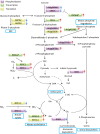Quantitative phosphoproteome profiling of iron-deficient Arabidopsis roots
- PMID: 22438062
- PMCID: PMC3375974
- DOI: 10.1104/pp.112.193987
Quantitative phosphoproteome profiling of iron-deficient Arabidopsis roots
Abstract
Iron (Fe) is an essential mineral nutrient for plants, but often it is not available in sufficient quantities to sustain optimal growth. To gain insights into adaptive processes to low Fe availability at the posttranslational level, we conducted a quantitative analysis of Fe deficiency-induced changes in the phosphoproteome profile of Arabidopsis (Arabidopsis thaliana) roots. Isobaric tags for relative and absolute quantitation-labeled phosphopeptides were analyzed by liquid chromatography-tandem mass spectrometry on an LTQ-Orbitrap with collision-induced dissociation and high-energy collision dissociation capabilities. Using a combination of titanium dioxide and immobilized metal affinity chromatography to enrich phosphopeptides, we extracted 849 uniquely identified phosphopeptides corresponding to 425 proteins and identified several not previously described phosphorylation motifs. A subset of 45 phosphoproteins was defined as being significantly changed in abundance upon Fe deficiency. Kinase motifs in Fe-responsive proteins matched to protein kinase A/calcium calmodulin-dependent kinase II, casein kinase II, and proline-directed kinase, indicating a possible critical function of these kinase classes in Fe homeostasis. To validate our analysis, we conducted site-directed mutagenesis on IAA-CONJUGATE-RESISTANT4 (IAR4), a protein putatively functioning in auxin homeostasis. iar4 mutants showed compromised root hair formation and developed shorter primary roots. Changing serine-296 in IAR4 to alanine resulted in a phenotype intermediate between mutant and wild type, whereas acidic substitution to aspartate to mimic phosphorylation was either lethal or caused an extreme dwarf phenotype, supporting the critical importance of this residue in Fe homeostasis. Our analyses further disclose substantial changes in the abundance of phosphoproteins involved in primary carbohydrate metabolism upon Fe deficiency, complementing the picture derived from previous proteomic and transcriptomic profiling studies.
Figures





References
-
- Bauer P, Ling HQ, Guerinot ML. (2007) FIT, the FER-LIKE IRON DEFICIENCY INDUCED TRANSCRIPTION FACTOR in Arabidopsis. Plant Physiol Biochem 45: 260–261 - PubMed
-
- Bodenmiller B, Mueller LN, Mueller M, Domon B, Aebersold R. (2007) Reproducible isolation of distinct, overlapping segments of the phosphoproteome. Nat Methods 4: 231–237 - PubMed
-
- Brumbarova T, Matros A, Mock HP, Bauer P. (2008) A proteomic study showing differential regulation of stress, redox regulation and peroxidase proteins by iron supply and the transcription factor FER. Plant J 54: 321–334 - PubMed
Publication types
MeSH terms
Substances
LinkOut - more resources
Full Text Sources
Medical
Molecular Biology Databases

